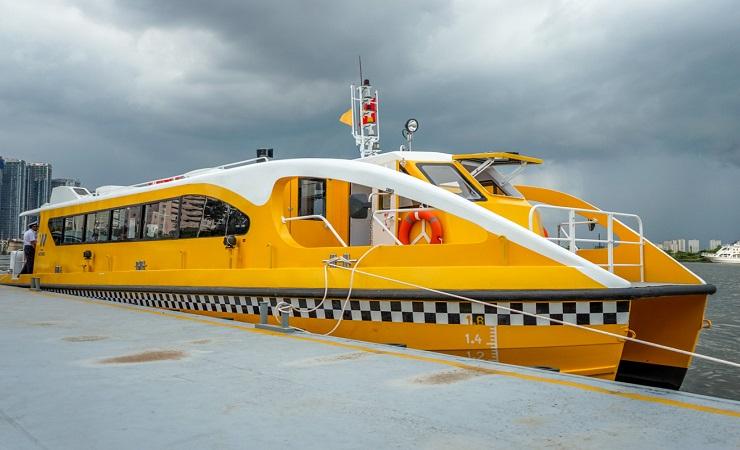ASIACALLING
Ho Chi Minh City’s New Waterbus is a Hit, but Traffic Challenges Remain
"Congested streets, hazy grey skies, and slow moving traffic – it’s probably a painfully familiar picture to anyone who has spent time in any of Asia’s big cities like Delhi, Manila, or Jakarta."
Michael Tatarski

Congested streets, hazy grey skies, and slow moving traffic – it’s probably a painfully familiar picture to anyone who has spent time in any of Asia’s big cities like Delhi, Manila, or Jakarta.
From Ho Chi Minh City in Vietnam, reporter Michael Tatarski takes a look at an innovative solution to the city’s transport nightmare.
The first thing any visitor to Ho Chi Minh City will notice is the traffic. An endless stream of motorbikes courses down every street. At rush hour traffic overflows onto sidewalks. Commuters wear masks to try and save themselves from the suffocating pollution.
“A key challenge is that people are heavily dependent on the motorbikes; there is at least one motorbike in every household,” explained Daisuke Mizusawa, a senior transport specialist at the Asian Development Bank’s office in Hanoi.
“ In order to promote the usage of public transportation systems it’s imperative to promote a modal shift by changing people’s behavior and lifestyle,” he continued.

The unofficial population of Ho Chi Minh City is a staggering 13 million.
Like many other Southeast Asian cities, infrastructure is struggling to keep up as more people move in from the provinces, and as incomes rise.
Up to 1,000 new cars are added to the streets every day. There are already over 7 million registered motorbikes on the road.
There’s an urgent need to develop mass transport before the city grinds to a halt.
“In the city we have about 112 bodies of water and 1,000 km of waterways. In comparison with other cities in the country, Ho Chi Minh City has some of best access to water,” said Nguyen Van Len, the chairman of Saigon Waterbus. “These are great conditions for us to create a water project,” he went on. Len believes Ho Chi Minh City’s future lies in water-based transport.
Last month, the privately owned Saigon Waterbus opened on the Saigon River. It was welcomed with open arms.
During a 10-day free ride period, tickets sold out hours in advance as excited passengers came to experience this new way to get around.
“I’m trying this out today to compare it to other ways to get around,” said commuter Vo TheGia. “If the city continues to develop these services, that’s going to attract a lot of people because traveling by water has always been a dream.”

Len adds that Vietnamese people feel a deep appreciation for water-based systems.
“Vietnamese people have always said that water and land are connected,” Len explained. “That’s a very important element for Vietnamese people, and the word for water in Vietnamese also means the country of Vietnam, so water is very important to Vietnamese people. That’s what inspired us to create this project.”
The waterbus has made modest inroads to the city’s traffic dilemma. But with just four 80-seat boats operating, it’s still just a drop in the ocean of the city’s transport needs
Mizusawa, the ADB expert, explains that along with other crowded cities like Manila and Jakarta, Ho Chi Minh City is racing to complete large-scale transport projects to alleviate traffic congestion.
“This is a very challenging issue in Vietnam and other emerging cities in Southeast Asia too,” Mizusawa stated.
“In Thailand they first developed the mass rapid transit (MRT) system in Bangkok in the 1990s, and at that time only one line was built, and nobody used it; there was no network effect. After that Thailand aggressively developed the network and now people’s lives are changing by relying on the use of the MRT. It took time,” he said.

Ho Chi Minh City’s first metro line is expected to be completed in 2020, after years of delay. Other lines are planned, but construction hasn’t begun on any of them yet.
There’s still a lot of room for expansion, but the first waterbus route has offered commuters a new way to get off the busy roads, while enjoying the view of the growing skyline. That is a step in the right direction.
Len hopes this is just the beginning: “When we create the infrastructure for this system, I hope that it will also support other water-based transportation that is aligned with the vision of the city.”
- Michael Tatarski
- Vietnam
- Mass Transport
- Saigon Waterbus
Komentar (0)
KBR percaya pembaca situs ini adalah orang-orang yang cerdas dan terpelajar. Karena itu mari kita gunakan kata-kata yang santun di dalam kolom komentar ini. Kalimat yang sopan, menjauhi prasangka SARA (suku, agama, ras dan antargolongan), pasti akan lebih didengar. Yuk, kita praktikkan!